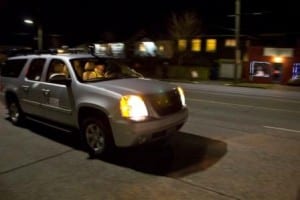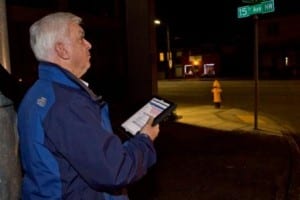 The Northwest Energy Efficiency Alliance (NEEA) and the City of Seattle are taking a look at the future of solid-state street lighting in the Pacific Northwest during a three-night streetlight test in Seattle’s Ballard neighborhood that continues through March 8.
The Northwest Energy Efficiency Alliance (NEEA) and the City of Seattle are taking a look at the future of solid-state street lighting in the Pacific Northwest during a three-night streetlight test in Seattle’s Ballard neighborhood that continues through March 8.

Testers ride in this vehicle. When they spot targets on the road, they click a button that records how far away they are.
The Northwest Energy Efficiency Alliance (NEEA) and the City of Seattle are taking a look at the future of solid-state street lighting in the Pacific Northwest during a three-night streetlight test in Seattle’s Ballard neighborhood that continues through March 8.
The study will demonstrate the effectiveness of solid-state lighting using LEDs. NEEA, working with Seattle City Light and the Seattle Department of Transportation, will test the theory that the broad spectrum of light from SSL products will let municipalities and utilities dim streetlights to lower levels, saving significant energy while still making streets safer for drivers and pedestrians. Solid-state lighting enhances peripheral vision, depth of field and color representation.
“We are doing this study at a critical time, since many streetlights are at the end of their lifespan and cities have to make sound business decisions with currently little technical proof that this new technology is better, cheaper and safer,” said Jeff Harris, director of emerging technology at NEEA. “Our work here is intended to ‘prove out’ the real performance of these new street lighting technologies where it counts – on the street. This is a great example of NEEA and its utility partners filling the energy efficiency pipeline by introducing newer field-tested technologies that deliver energy and money savings to the region.”
Results from the Seattle test will be combined with data from streetlight tests in other cities to create a regional design guide for Northwest municipalities – and municipalities across North and South America – looking to replace existing high-pressure sodium lights.
“These tests will illustrate how LED streetlights use far less energy while maintaining safety and better vision for Seattle residents,” said Edward Smalley, director of the U.S. Department of Energy’s Municipal Solid State Street Lighting Consortium.
Seattle City Light has already installed 20,000 LED streetlights. They have reduced energy consumption by more than 40 percent compared to the high-pressure sodium lights they replaced. By adding control systems, these public lighting sources could save 25 percent more.
“We’re excited to leverage NEEA’s regional connections for these tests,” Smalley said. “We believe this will encourage many other communities to join Seattle in adopting more energy-efficient lighting.”
Currently the Northwest has 1.7 million street lights. Many of these fixtures are nearing their end of life, and are both energy inefficient and expensive to maintain. Municipalities and utilities are showing more interest in LEDs for streetlights to save costs and increase customer safety. Solid-state lighting using LEDs offers huge energy savings.
In general, LED streetlights can use up to 50 percent less energy than traditional street lighting technologies. By adding control systems, these public lighting sources could save another 25 percent.

There's an app for that LED streetlight. Controls on the test lights can be operated by SDOT from any computer.
According to the Northwest Power and Conservation Council’s 6th Plan and independent analysis by NEEA, the Northwest has the potential to save up to 115 average megawatts of electricity each year by adopting solid-state LED streetlight technology. This is the equivalent to powering 87,750 homes per year—greater than the current number of households in Tacoma.
“The Seattle LED streetlight tests will guide the national move to LED streetlight technology,” said Dr. Ronald B. Gibbons, director, Center for Infrastructure Based Safety Systems, Virginia Tech Transportation Institute. “We want to help cities and municipalities offer residents better safety with lower operating costs and less energy use.”
For the actual test, a professional driver will pilot an instrumented car on blocked-off streets while passengers perform object detection tests at 35 mph along the route. Both traditional streetlights and LED lights will be used to compare how participants see the same objects under different lighting levels. Residents will also walk the course and rate the streetlights based on their perceptions of quality and safety.
The object detection tests will be combined with the pedestrians’ input to create a recommended standard for LED street lighting across the United States and South America.
Other partners in the study include Clanton and Associates, Continuum Industries, and Virginia Tech Transportation Institute.
About the Northwest Energy Efficiency Alliance
The Northwest Energy Efficiency Alliance (NEEA) is a non-profit organization working to maximize energy efficiency to meet our future energy needs. NEEA is supported by and works in collaboration with the Bonneville Power Administration, Energy Trust of Oregon and more than 100 Northwest utilities on behalf of more than 12 million energy consumers. NEEA uses the market power of the region to accelerate the innovation and adoption of energy-efficient products, services and practices. Since 1997, NEEA and its partners have saved enough energy to power more than 568,400 homes each year. Energy efficiency can satisfy more than half of our new demand for energy, saving money, and keeping the Northwest a healthy and vibrant place to live. www.neea.org
About Seattle City Light
Seattle City Light is the 10th largest public electric utility in the United States. It has some of the lowest cost customer rates of any urban utility, providing reliable, renewable and environmentally responsible power to nearly 1 million Seattle area residents. City Light has been greenhouse gas neutral since 2005, the first electric utility in the nation to achieve that distinction. http://www.seattle.gov/light/
About the Seattle Department of Transportation
Seattle Department of Transportation’s mission is to create and maintain for Seattle a safe and reliable transportation system which enhances neighborhoods, the environment and the economy. Everything the department does is aimed at enhancing mobility within the city; this department has as its vision to be the most innovative and responsive transportation agency in the region. The viability of our neighborhoods and the health of our region’s economy are dependent upon access and mobility. http://www.seattle.gov/transportation/